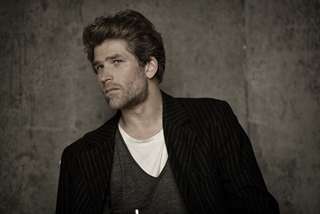|
Back
The French Sound Expands New York
Alice Tully Hall, Lincoln Center
03/19/2017 -
Claude Debussy: Quartet in G minor for Strings, Op. 10, L. 85 – Sonata No. 3 for Violin and Piano in G minor, L. 140
Maurice Ravel: Sonata for Violin and Piano No. 2 in G major – Quartet in F major for Strings
Nicolas Dautricourt (violin), Anne-Marie McDermott (piano), Escher String Quartet: Adam Barnett-Hart, Aaron Boyd (violins), Pierre Lapointe (viola), Brook Speltz (cello)

N. Dautricourt (© Bernard Martinez)
“My friend Bruce Adolphe calls it a croissandwich because it’s an American form, refracted through French.”
Jeremy Denk on the Ravel Sonata
Yehudi Menuhin often told how he was having a lesson at the flat of Georges Enescu in Paris when Maurice Ravel burst in with the manuscript of his brand new Sonata for Violin and Piano No. 2 and proceeded to run through it with Enesco at the violin. After it was over, the violinist was so enthusiastic about his friend’s new work that he begged to play it a second time. Closing the printed part, he dug into it again with Ravel still at the piano. Not once did the Romanian fiddler need to consult the score: he had it in both his mind and his fingers!
Ravel moved French music in two new directions at once, combining Jewish tradition and Basque idiom with the American influence of jazz, whereas Debussy dragged all Western music kicking and screaming into the world of polytonality. Hearing both of these refreshing new media in one evening was simply thrilling.
I have been a huge fan of pianist McDermott for over a dozen years, in fact when I used to give out the “Lully awards” here is what I wrote in 2002:
“...when such daring performers as Anne-Marie McDermott and Nadja Salerno-Sonnenberg expose the raw nerve endings of the Brahms “Rain” Sonata to public scrutiny and approach the experience positively religiously, one can only shudder in admiration. The remainder of this concert, populated with other performers, was only average, but this shimmering rendition, so perfect in its fragile vulnerability, will remain in the memory for many years to come.”
Back to the present. The team of Dautricourt and McDermott were not only note-perfect but captured the risk-taking spirit of the Ravel. I always have the same problem with the blues movement because we modern listeners are hearing it with the overlay of decades of “country” music, down home Southern ballades and zydeco, whereas this present duo’s gingerly approach was much more historically accurate. This is not Marty McFly going back in time to play Chuck Berry (RIP) music, but a more subtle introduction of a very different type of sound. The large crowd reacted audibly at the conclusion of the movement, causing the performers to smile as well. A meaningful connection.
In the Debussy sonata, language and imagery are the cohesive factors. Movement, form and order are conventional but truncated. Here was the most impressive performance of the evening, capturing, especially in the “Intermède” the, as Schoenberg said, “air of another planet”.
If Debussy had written his quartet in the California of the 1960’s rather than the Paris of the 1890’s, it would have been described by contemporary publications as “freewheelin’”. Like his Prélude à l’après-midi d’un faune, particular and peculiar asymmetric modulations are experienced by audiences for the first time in music history. The quartet also moves from one tempo to another, one mood to another, one form to another in an unprecedented and amazingly forward-looking manner. This was a good performance, however the overall sound needs seasoning. Of course this is the mission of the Chamber Music Society, to present great performances by veterans and encourage younger musicians to grow stronger and more eloquent with time. Here the most impressive movement was the Andantino, its quietude and mystery adroitly expressed.
Not having heard the Ravel quartet at Alice Tully live for an entire week led to the realization that it is one of the most popular chamber works of the last century, the annals of Music Mountain back home in Connecticut indicating that it has been performed there more than any other chamber work, irrespective of period. Here the Escher group was strong and the viola solo by Mr. Lapointe in the “Très lent” movement was remarkably moving, a fitting end to a satisfying evening. I will be hearing this same opus in May by the Emerson. It will be fun to compare this trio of quartets.
Fred Kirshnit
|